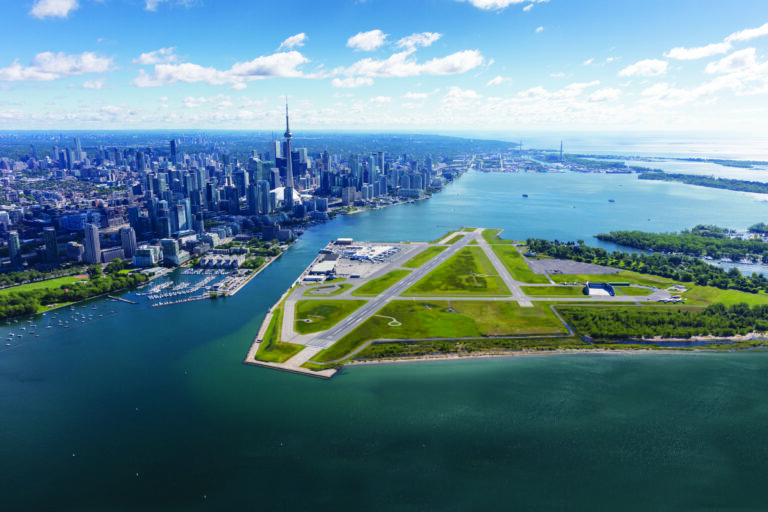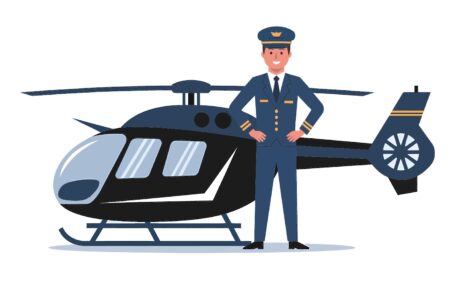Imagine an international airport on a parkland island — one so close to downtown that you can walk to it using a tunnel under the lake. This isn’t fantasy — it’s the Billy Bishop Toronto City Airport (YTZ), located on the western edge of the Toronto Islands. A short distance across Lake Ontario from the city’s skyscraper-filled core, Billy Bishop Airport serves both business and general aviation, and has been doing so since 1939.
“It was built as Toronto’s first and primary airport,” says RJ Steenstra, president and CEO of PortsToronto, which manages YTZ and the City’s lakeside port facilities. “Due to fog being an issue on the lake, the City decided that it needed an alternative inland airfield as well — which is now known as Toronto Pearson International Airport.”
Today, Billy Bishop Airport serves 2.8 million passengers annually, with airline links to 20 cities in Canada and the US via Air Canada and Porter Airlines. Yet, despite this significant traffic load, Billy Bishop Airport does not dominate the city’s waterfront or popular Toronto Islands’ public park. It is this balance between business, nature, and nearby condo towers that makes YTZ unique, albeit at the cost of a limit on the types of aircraft allowed to land and takeoff there.
Top flight facilities
Although it is small in comparison to Toronto Pearson Airport, Billy Bishop Airport is well-equipped. It has two overlapping asphalt runways: Runway 08/26 (approximately 3,988 feet/1,216 metres in length) and Runway 06/24 (approximately 2,460 feet/750 metres) YTZ is open for traffic daily from 5:00 AM to 11:00 PM, with operations outside these hours restricted to medevac flights. Billy Bishop Airport supports general/commercial aviation and business flights through two primary Fixed Base Operators (FBOs) located onsite.
The Porter FBO provides full-service FBO offerings, such as fuel, hangar and ramp parking. It also has lounges, meeting rooms, and crew facilities with daily hangar and ramp space availability. Stolport Corporation FBO offers full FBO services including aircraft handling and support, plus facilities for private and charter operations. Both FBOs sell Jet A and 100LL aviation fuels.
A modern two-story passenger terminal built in 2010 supports 11 gates and Canadian Customs clearance on its top floor. The terminal also has food service, stores, and car rental agencies on its ground level.
As mentioned above, an underground tunnel makes it possible to walk from YTZ underneath the Western Gap shipping channel to downtown Toronto. Complimentary shuttle buses to the downtown area are also provided.

For those needing to ship larger items and vehicles, or just wanting a brisk boat voyage across Lake Ontario, there’s the all-electric Marilyn Bell 1 ferry. It sails the Western Gap and runs from 05:15 AM- 12:07 AM daily, with ferry crossings every 15 minutes. The distance between both shores of the Western Gap is just 397ft (121m). As a result, a single voyage takes only 90 seconds, making the ferry ride to and from Billy Bishop Toronto City Airport one of the shortest in the world.

A pioneer of Toronto aviation
The push to build the airport, originally known as Port George VI Island, began in the 1920s, with the growth of airplane flights in the area. The lakeside location was an ideal choice, given its ability to serve seaplanes and wheeled aircraft from a single location. Being close to downtown also helped. But it wasn’t a pain-free decision. Building YTZ meant that Hanlan’s Point Amusement Park and Hanlan’s Point Stadium, where Babe Ruth hit his first professional home run on September 5, 1914, had to be demolished.

Construction of the runways, original terminal building, which is still in existence, but moved off its original site and now in decay, and hangars was started in 1937.
Two years later, the airport was ready for business. On February 4, 1939, Montreal’s H.F. McLean was the first to land at YTZ in his Stinson SR-9F Reliant highwing monoplane. On September 8, 1939, Tommy Dorsey and his swing-band arrived in Toronto on an American Airlines DC-3, making theirs the first commercial flight to land at YTZ. During WW2, the airport became a military training base for the Royal Norwegian Air Force from 1940 to 1943. After the war, it reverted to 100% civilian service. It was renamed as Billy Bishop Toronto City Airport in 2009 to honour William Avery “Billy” Bishop. He was a Canadian First World War flying ace and Victoria Cross recipient, who played a part in the airport’s initial construction. The tunnel that was opened in 2015 was supposed to have been built in the 1930s along with the airport. But that project was killed due to a change in Canadian government and the partially-dug hole for the original tunnel filled in.

It isn’t easy running an airport in a downtown area. There aren’t just office workers, Toronto Islands visitors, about 1.5 million annually, have to be considered too. Nearby is the Toronto Union Station with its rail passengers, 65 million annually, although most stay indoors. “We have about 55,000 people that live right around the airport in condo developments,” Steenstra says, “Many of them use the airport, walking to it from their homes.”

With all those people close by, noise pollution caused by aircraft engines is a constant concern. This is why Billy Bishop’s flight hours are restricted, its aircraft are required to taxi using single engines, and its noise levels are capped at a Noise Exposure Forecast (NEF) level of 25. This limit is set by Transport Canada, the Canadian aviation regulator. These limits explain why jet aircraft are not allowed at Billy Bishop Airport, either for commercial or business flights. This is why Air Canada and Porter only fly Bombardier Q400 turboprops in and out of YTZ, and why business aircraft are limited to propeller planes. “If it’s King Airs and that type of aircraft, we can enable their takeoff and landing at the airport,” Steenstra says. “But we’re constrained from enabling jets to land at the airport, due to our limits on noise.”
One of the most innovative ways that Billy Bishop Airport has moved to reduce its noise footprint is by building a Ground Run-up Enclosure (GRE) in 2017. As the name suggests, the GRE is an open-air, acoustic engineered structure designed to dampen the noise produced by engine maintenance run-up inspections. “When an aircraft goes into the GRE to do their run-ups, you cannot hear it any longer,” says Steenstra. “Actions like that speak volumes about how we listen to the community, to ensure that the impact of operating an airport in a downtown urban setting is minimized.”

Billy Bishop Airport’s air traffic controllers, NAV CANADA, also direct as many aircraft as possible to approach the airport over water rather than land. This helps to reduce airport noise. So does YTZ’s Calm Wind Runway procedure, where aircraft take off and land at the airport from west to east during periods when wind speeds are below five knots.

Here to stay
Despite the many challenges it faces operating in downtown Toronto, Billy Bishop Airport appears destined to stay in business for the long haul.
In October 2024, for instance, Toronto City Council approved extending its lease past its 2033 end date to 2045.
“We’re in the middle of developing a new US Customs pre-clearance site at the airport,” Steenstra says. “It will be the ninth pre-clearance site at a Canadian airport, and will allow us to provide more convenience and speed to our international passengers and pilots.”

All told, Billy Bishop Airport has enjoyed an amazing 86 year career in downtown Toronto. And it isn’t over yet — even if Toronto Pearson has long since outgrown its supporting role as Billy Bishop’s inland backup!





